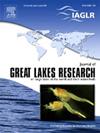Vertical distribution of Lake Superior cisco (Coregonus artedi) spawning aggregations and implications for population monitoring
IF 2.5
3区 环境科学与生态学
Q3 ENVIRONMENTAL SCIENCES
引用次数: 0
Abstract
Cisco (Coregonus artedi) support an evolving commercial roe fishery in Wisconsin waters of Lake Superior. To monitor trends in spawning cisco abundance, fishery managers recently began estimating adult biomass and exploitation using fall hydroacoustic surveys, which were combined with gill net surveys to inform apportionments of acoustic data. The gill net survey design consisted of paired top-suspended and bottom-set gill nets, but only the sex ratios from top nets are currently used with the hydroacoustic surveys due to an assumption that cisco in Lake Superior are pelagic spawners. However, the vertical sex distribution of cisco during spawning aggregations has been described as dynamic, with males becoming more bottom-oriented throughout the spawning season. We used multilevel aggregated binomial regressions to: 1) determine if there is bias between top and bottom gill net catches of cisco for either sex and if it changes throughout the spawning season, 2) evaluate how the vertical distribution of males and females may create bias in sex ratios used to estimate exploitation, and 3) explore the effect that maturity (i.e., gonadal development) has on vertical distribution during spawning aggregations. We identified sex-specific bias in vertical catch location that has the potential to bias estimates of sex ratio, and the source of this bias may be attributable to maturity driven changes in behavior. These findings highlight a need for caution when relying on gill nets to apportion cisco sex ratios during spawning aggregations and provide support for a non-pelagic alternative hypothesis of spawning behavior.
苏必利尔湖矶鳕产卵群的垂直分布及其对种群监测的影响
在苏必利尔湖的威斯康星水域,矶沧鱼()支撑着不断发展的商业鱼子渔业。为了监测产卵矶沧鱼的丰度趋势,渔业管理者最近开始利用秋季水声调查估算成鱼生物量和捕捞量,并将其与刺网调查结合起来,为声学数据的分配提供信息。刺网调查设计包括成对的上悬刺网和下沉刺网,但由于假设苏必利尔湖中的思科鱼是中上层产卵者,目前只有上层刺网的性别比例被用于水声调查。然而,矶沧鱼在产卵聚集期间的垂直性别分布被描述为动态的,在整个产卵季节,雄性矶沧鱼更倾向于底层。我们使用多级聚合二叉回归法来1)确定雌雄矶沧鱼的顶部和底部刺网渔获量之间是否存在偏差,以及这种偏差是否会在整个产卵季节发生变化;2)评估雌雄矶沧鱼的垂直分布如何导致用于估算开发量的性别比例出现偏差;3)探索成熟度(即性腺发育)对产卵聚集期间垂直分布的影响。我们发现,垂直捕获位置的性别特异性偏差有可能导致性别比估计值的偏差,而这种偏差的来源可能是成熟度驱动的行为变化。这些发现突出表明,在产卵聚集期间,依靠刺网来分配矶沧鱼性别比例时需要谨慎,并为产卵行为的非深海替代假说提供了支持。
本文章由计算机程序翻译,如有差异,请以英文原文为准。
求助全文
约1分钟内获得全文
求助全文
来源期刊

Journal of Great Lakes Research
生物-海洋与淡水生物学
CiteScore
5.10
自引率
13.60%
发文量
178
审稿时长
6 months
期刊介绍:
Published six times per year, the Journal of Great Lakes Research is multidisciplinary in its coverage, publishing manuscripts on a wide range of theoretical and applied topics in the natural science fields of biology, chemistry, physics, geology, as well as social sciences of the large lakes of the world and their watersheds. Large lakes generally are considered as those lakes which have a mean surface area of >500 km2 (see Herdendorf, C.E. 1982. Large lakes of the world. J. Great Lakes Res. 8:379-412, for examples), although smaller lakes may be considered, especially if they are very deep. We also welcome contributions on saline lakes and research on estuarine waters where the results have application to large lakes.
 求助内容:
求助内容: 应助结果提醒方式:
应助结果提醒方式:


